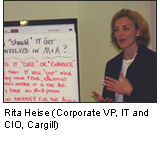
|
|
|
 |
|

|
Fueling Business Strategy through IT/Finance Alignment
Thought Leadership Summit on Digital Strategies June 7, 2005 - New York, NY CIOs and senior finance execs from American Express, Cargill, Cendant, Cisco, Citigroup, Eaton, IBM, Staples, and Whirlpool were joined by academics from Tuck and Wharton for this roundtable. This was the tenth summit in the Thought Leadership Summit on Digital Strategies series. |
||
|
Press Release
Agenda
List of Participants
Discussion Guide
Overview Article
|
|||||
How do CFOs and CIOs view the opportunities and challenges that lie ahead of them? How can IT and Finance work together more closely to create business value? What are best practices in compliance, performance management, and the alignment of IT investments with business priorities?
In bringing together leading CIOs and their senior finance executive colleagues, this roundtable produced the following compelling insights:
- CFOs and CIOs must think broadly about performance management, using metrics to launch a dialog about end-to-end value creation in the business. Metrics decay over time however, and must be refreshed as the business evolves, especially in key categories (operational, financial, customer and employee-related).
- Performance management should be culturally ingrained, and built on a foundation of high integrity and consistent data. CIOs can help enable performance management by laying the technology foundations for enterprise-wide ‘single version of the truth’ data.
- Controls should be ‘baked-in’ to enterprise processes and IT infrastructure at a low level to embed compliance and avoid costly distractions. Management should simultaneously try to inculcate a controls-oriented mindset throughout the organization.
- Sarbanes-Oxley has helped CIOs push through previously unfundable initiatives that made long term business sense, such as standardizing and globalizing systems and processes. But both IT and Finance should be careful about hiding behind compliance or using it as a means to achieve other ends.
- CIOs and CFOs are concerned that the recent wave of regulation may be creating a risk-averse environment and hampering corporate innovation. Will U.S. companies be afraid or unable to move fast in the battle against global competitors who aren’t similarly encumbered?
-
CFOs want CIOs to reduce ongoing maintenance costs to free up funds for new projects, and to develop a more variable labor cost structure. But how close CIOs can get to a 100% variable IT labor structure is subject to intense debate, given the learning curve for company-specific processes.
-
CIOs should maintain a two-way dialog with the business about needs, and ‘overcommunicate’ throughout the lifecycle of major IT projects. Getting buy-in and alignment on goals and expectations—and communicating this throughout the ranks—is crucial to IT project success.
-
Risk management is an increasingly important dialog within large enterprises. CFOs and CIOs should work together to determine an appropriate level of IT infrastructure spend based on a risk model, external benchmarks, and other frameworks for ‘value preservation.’
![]()
| Learn how to build strategic relationships between CIOs and HR execs - read key learnings from "Gaining Competitive Advantage through Human Resources Management." | |
| "CIOs and CFOs Find Opportunities and Challenges in IT/Finance Alignment," Knowledge@Wharton. | |
| To link to the Thought Leadership Summit on Digital Strategies website, click here. | |